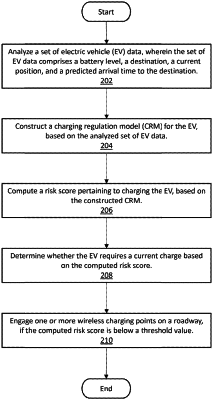| CPC G01C 21/3469 (2013.01) [B60L 53/12 (2019.02); B60L 58/10 (2019.02); G06N 20/00 (2019.01); G01S 19/42 (2013.01)] | 18 Claims |

|
1. A computer-implemented method for determining whether an electric vehicle (EV) is to be provided a charge, the method comprising:
analyzing a set of EV data, wherein the set of EV data comprises a battery level, a destination, a current position, and a predicted arrival time to the destination;
constructing a charging regulation model for the EV, based on the analyzed set of EV data;
computing a risk score pertaining to charging the EV as the EV travels along a roadway, based on the constructed charging regulation model for the EV;
based on the computed risk score being above a threshold value, determining that the EV is to be provided a charge as the EV travels on the roadway; and
based on determining that the EV is to be provided a charge as the EV travels on the roadway, selectively engaging, according to a minimum additional battery charge, one or more wireless charging points on the roadway to provide the charge to the EV as the EV travels on the roadway, wherein the selectively engaging comprise engaging the one or more wireless charging points to provide the minimum additional battery charge and disengaging at least one wireless charging point based on detecting that the minimum additional battery charge has been provided to the EV.
|